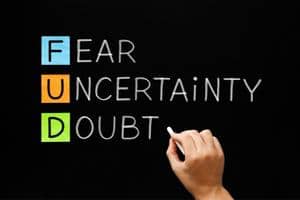How to Deal With Uncertainty in Business
It’s no secret that owning a business comes with some level of uncertainty. You never know which event will arise in the future that causes your business to fail. You could be doing well one year, and then the following year, a global recession occurs and negatively affects your sales. But while you can’t predict nor control uncertainty, there are some things you can do to ensure your business survives.
In this post, we will discuss the meaning of uncertainty then mention the types and sources. We will also provide tips to help you navigate uncertainty to ensure your business gets through any unforeseen crisis.
What is Uncertainty in Business?
Uncertainty refers to any unforeseen and unmeasurable event that arises and impacts your business, mostly negatively. You can’t predict nor influence the outcome of uncertainty. You may also have a challenging time assessing the performance of your business during this unprecedented situation. Finally, there’s no way to know how much sales or profits your business will make or predict when the unforeseen event will end and how it will affect your business.

Uncertainty is an inherent part of being in business. It affects enterprises of all types and sizes, but startups and small businesses are the ones that take the biggest hit. Most startups operate in financial uncertainty during normal economic times. When an unforeseen event occurs, it limits their access to funding from investors. As a result, startups and small businesses are more likely to fail in the event of uncertainty.
Difference Between Uncertainty and Risk
Uncertainty and risk may sound similar, but they’re two different concepts. Risk in business refers to the chance that the outcome of an investment will deviate from the expected. Risk is also a natural part of starting and running a business. But unlike uncertainty, it is predictable and controllable.
You usually know the potential outcomes of risk, and you can measure them in advance using past performance and historical data. You can also predict how risk will affect your business. Another difference is most risks occur internally, while uncertainty arises from external sources.
Examples of risk include:
- Financial loss from investing in something new
- Risk of losing your products to natural disasters or theft
- Loss of data from hacking and cybersecurity threats
Types of Uncertainties in Business With Examples
Economic Uncertainty
Economic uncertainty arises from unforeseen changes in the economy. For example, an economic recession can occur and lead to loss of employment. In turn, it affects your business’s sales due to a decline in consumer spending.
Economic uncertainty can also occur due to changes in exchange rates and interest rates. For instance, say you own a wool manufacturing business, and you rely on overseas supplies. If your currency loses value against that of your supplier, you may end up paying more than you intended. Your other alternative may be to search for a supplier in another country or source locally.
A rise in interest rates affects your business in numerous ways. It can affect your sales because there is less supply of money in the economy. People borrow less when interest rates are high. It can also limit your chances of securing funding and reduce your cash flow because you may have to set aside more money to repay debt.
Political Uncertainty
Political uncertainty emerges from changes in government policies or any other political situation. This uncertainty can have a profound impact on the economy and consumer behavior.
Examples of political uncertainty include political protests and movements, election-related violence, and trade sanctions.
A real-world example of political uncertainty is Brexit which occurred in the United Kingdom. The United Kingdom withdrew from the European Union in February 2020. This move affected trade agreements, import and export tariffs, and the availability of employees for businesses in and out of the UK.
Political uncertainty disrupts the day-to-day activities of a business. It can also limit access to funding for small businesses and startups since investors may be hesitant to invest during a political crisis.
Social and Environmental Uncertainty

Some natural disasters, like earthquakes, can be anticipated using historical data. In this case, the natural disaster becomes a risk and not a business uncertainty. You can mitigate the risk of that disaster occurring. For example, assume you want to open a business in Central Tokyo. You may know that this city is prone to earthquakes. You can take preventive measures by applying for earthquake insurance coverage or renting your office in an earthquake-proof building.
Sources of Uncertainty in Business
Business uncertainty can arise from many sources, including:
- War and violence
- Natural calamities
- Protests and strikes
- Economic recessions and booms
- Pandemics and epidemics
- Changes in government policy and business regulation
How to Deal With Uncertainty in Business
Even though you can’t predict nor control uncertainty, you can set up plans and strategies to navigate and reduce the impact. Here are some tips and insights to help you deal with business uncertainties.
Focus on Things in Your Control
The first step to navigating uncertainty is accepting the variables you can’t control and focusing on the ones you can. For example, you can’t control changes in market prices and government policies. Worrying about these events won’t do your business any good. It may lead to anxiety, which might affect your productivity or that of your team. It’s best to accept that the uncertainty has occurred and find ways to reduce its impact on your business.
Take Stock of Your Business
Another thing you can do to help deal with uncertainty is to revisit your financial statements and take note of your business’s current state. How much inventory do you have, and how long can it last? What’s your cash flow, revenue, and expenses position? Taking stock of your financial information will help you plan your pivot strategy and create a budget for overcoming the uncertainty.
Create a Contingency Plan or a Crisis Management Plan

Here is a guide on how to create a contingency plan or a crisis management plan:
- Brainstorm for worst-case scenarios
Identify risks and uncertainties that your business might face. The best way to do this is by asking “what if” questions. What if a pandemic or a natural disaster occurs? What if the government passes a new policy that affects our supply chain? You can then prioritize the uncertainties by assessing the probability of them occurring and the impact they might have on your business.
- Create a plan for disaster management
Your contingency or crisis management plan should provide steps to get your business back to normal after the predetermined uncertainty occurs. There is no right or wrong way to create the plan, but you can include the following information:
- Describe the uncertainties that should happen for the plan to take action.
- Note down the team in charge.
- Write a step-by-step action or procedure for initiating the plan.
- Develop a strategy for communicating to your stakeholders, more so your customers and employees.
- Test the plan
You can test the plan by creating scenarios that require you to use it. Testing will help prepare your team better in case the predetermined uncertainty occurs. It will also help you identify loopholes in the contingency or crisis management plan.
- Update your plan regularly
You can update your contingency plan on a quarterly or yearly basis. Don’t just create the plan and forget it. Revisit it when a key team member leaves the business or when changes occur in your business environment.
Set Aside an Emergency Fund or a Cash Reserve
An emergency fund helps keep your business running when the economy is slow or during a crisis. It acts as insurance for your business and minimizes the financial impact of a risk or uncertainty. The amount of cash you transfer to your emergency fund is up to you and your business needs. But try to aim for enough money to cover your costs for at least three months.
The best way to calculate the amount you need is by reviewing your latest financial statements, especially your income statement and statement of cash flow. Once you determine your business’s financial performance, build your emergency fund gradually each month or quarter. A good tip would be to think of your emergency fund as another expense in your business so that you can commit to growing it.
Diversify Your Business’s Investments

There are four types of diversification. You can try horizontal diversification, where you invest in a product or service that compliments your core business. You may also try vertical diversification, where you invest in a product or service within your supply and production line. For example, if you own a milk processing company, you can invest in dairy farming or flavor extraction.
The other two diversification strategies that you can go for include:
- Conglomerate diversification for investing in products and services entirely different from your core business
- Concentric diversification for investing in products and services similar to the ones you sell
Be Flexible and Ready to Pivot
Being flexible enables you to adapt quickly to changes in your industry or market. It minimizes downtime in your operations and gives your business a better chance at overcoming an unexpected outcome.
Uncertainties such as natural disasters often require you to make decisions quickly and without all the information. You may have to amend your budget, change your strategy and introduce new systems into your business. Being flexible will allow you to pivot quickly and thus reduce the impact of the uncertainty.
For example, the COVID-19 pandemic caused many states to institute a lockdown policy that minimized outdoor movements. Flexible businesses quickly pivoted by allowing employees to work from home, introducing home deliveries, engaging in remote business meetings, among other things.
Prioritize Transparency
Effective communication is crucial during times of uncertainty. Be transparent with all the stakeholders of your business. Empathize with them and inform them about the state of your business. Keep your staff in the loop on your plans and strategies for reducing the impact of the uncertainty. You can ask for their suggestions on how to overcome this unfortunate event.
Being transparent will help you build confidence and gain the trust of your team. It will increase your team’s support for the changes and strategies you introduce to navigate the uncertainty. Transparency is also a first step towards building customer loyalty.
Conclusion

Business uncertainty can arise from many sources. It can emerge from a pandemic, natural disaster, new government policy, economic recession, and so on. The best way to deal with uncertainty is by creating a contingency or crisis management plan and setting aside a cash reserve for unforeseen events.
Consider also diversifying your investments to minimize the impact of the uncertainty. Embrace flexibility in your business so that you can pivot quickly. Lastly, keep your team in the know about your plan and strategy for overcoming any unexpected events.

